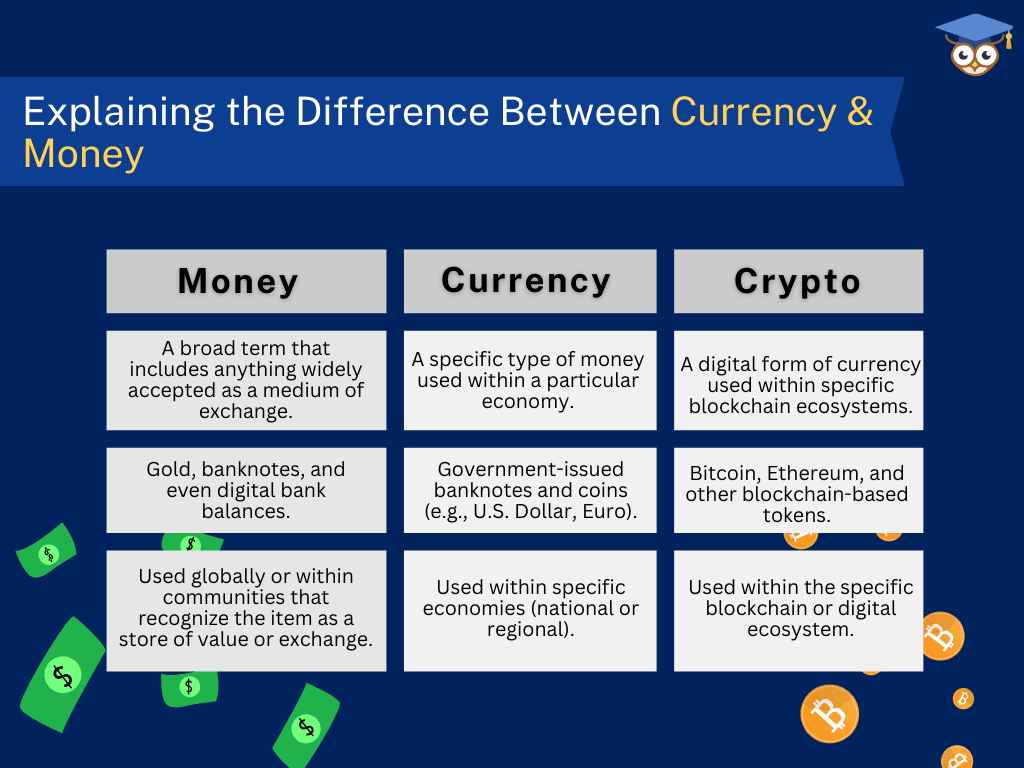How many times have you heard comments like “Crypto is a scam” or “Crypto isn’t real money”? These are pretty common and also incredibly inaccurate. Cryptocurrencies like Bitcoin and Ethereum have been around for years now. Bitcoin was born in 2009, for example.
But there’s still a common misunderstanding that needs to be addressed. People often believe you should be able to use these digital assets just like traditional money in everyday transactions. Imagine buying a soda with Bitcoin at your local convenience store or paying for groceries with Ethereum.
Sounds confusing, right?
It’s time that someone clears the air and explains why cryptocurrencies are indeed called “currency” despite these limitations. That someone is us! We’ll break down the basics for you, debunking these popular crypto myths, and illustrate why cryptocurrency deserves its title.
Why It’s Called Cryptocurrency
To kick things off, let’s define what a cryptocurrency is. At its core, a cryptocurrency is a digital or virtual form of currency that relies on cryptography for security.
But what does that even mean? Simply put, it’s secure and almost impossible to counterfeit. But you might be asking, “Why is it called currency if I can’t use it like dollars or euros?”
The term “currency” in cryptocurrency comes from its use within its own ecosystem. Each blockchain — the technology that underpins cryptocurrencies — has its own native token, which is used to pay for transactions on that specific blockchain.
For instance, if you want to make a transaction on the Bitcoin network, you’ll need Bitcoin to do it. Similarly, you need Ether for transactions on the Ethereum network and BNB to pay for transactions on the BNB chain.
Think of it as needing arcade tokens to play games at an arcade (for those who remember what those were) — you can’t use those tokens outside the arcade, but they still hold value in that facility.
If you walk out with some still in your pocket, you can use them the next time you visit. Or, you can give them to a friend if they’re planning on going in the near future and you don’t intend to.
Crypto Myths Debunked – Explaining the Difference Between Currency and Money

Here’s where things get interesting. The terms “currency” and “money” are often used interchangeably, but they’re not exactly the same. That’s probably why there is so much confusion and likely what’s birthing so many of these crypto myths.
Money is a broader concept that includes anything widely accepted as a medium of exchange. This can include physical items like gold or digital forms like bank balances.
Currency, on the other hand, is a type of money that is used within a particular economy. In this context, cryptocurrencies serve as currency within their own ecosystems or blockchains.
You can’t walk into a U.S. store and pay with Mexican Pesos, just like you can’t use Bitcoin in most retail stores. But that doesn’t make Bitcoin any less of a currency within its own realm.
For that matter, you can’t walk into a store and pay with stocks, either. Can you imagine walking up to a cashier and saying, “Do you take Nvidia?”
Understanding this distinction clarifies why cryptocurrencies exist, even if their everyday use cases are limited “in the real world”.
“But How Is Ethereum Used in Real Life?” – Use Cases and Limitations of Cryptocurrency

How is Ethereum used in real life? This question came from one of our social media followers, and we think it’s a good one that deserves a proper explanation.
Now that we’ve established why cryptocurrencies are called currencies, let’s look at their practical applications and limitations.
Cross-Border Transactions
One of the most significant uses of cryptocurrencies today is in cross-border transactions. Traditional banking systems often involve hefty fees and long processing times for international transfers.
This costs businesses that operate internationally, which is most of them, a fortune. That cost is passed on to the individual merchants carrying the merchandise and then further along to the customer.
Cryptocurrencies, however, offer a faster and often cheaper alternative. For example, someone in the U.S. can send ETH to someone in Japan within minutes, bypassing the usual banking fees.
Let’s take that and put it into the “real world” realm. A company can sell a volatile asset such as ETH or BTC for a stablecoin such as USDC or USDT and transfer that internationally to another company in exchange for goods or services.
If the company in question doesn’t want USD, it can also accept a volatile asset. Believe it or not, many of them are quite keen on acquiring volatile digital assets, especially in a down market.
The same company could also load USD onto a platform such as Coinbase and then sell that USD for the same stablecoins, which would prevent a taxable event. If you sell a dollar for a dollar, your profit is $0. And as much as the government would like to find a way to tax $0, they’ve yet to find a realistic way to do so.
Investment Opportunities
Another key use case is investment. Many people buy cryptocurrencies as a form of investment, hoping that their value will increase over time. Crypto can be purchased on platforms like Robinhood and centralized exchanges like Coinbase.
If investors want to go a bit deeper, they can transfer those funds to a non-custodial wallet and participate in DeFi. This has made crypto markets highly volatile but also potentially lucrative.
Limitations
Despite these benefits, cryptocurrencies have limitations. We’re not going to deny that. After all, our job is to educate and give our readers the absolute truth.
Their adoption as a common medium of exchange is still in its infancy. Volatility is a major issue; the value of Bitcoin can swing wildly in a single day, making it unreliable for everyday purchases.
Additionally, regulatory hurdles and a lack of understanding among the general public contribute to its limited use in daily transactions.
However, blockchain tech is already being used by companies worldwide. The biggest institutional financial players are involved, from Goldman Sachs to Blackrock. So it’s only a matter of time. With that said, let’s get into what the future could hold.
The Future of Crypto as Currency
Looking ahead, the question remains — will cryptocurrencies become mainstream methods of payment? Several factors suggest they could.
Technological improvements are continually being made to address current limitations. Innovations like the Lightning Network aim to make Bitcoin transactions faster and cheaper, which could eventually make it more viable for everyday use.
Mastercard has recently partnered with a company that will issue a crypto debit card in Europe.
More businesses are starting to accept cryptocurrencies, albeit slowly. Major companies like Tesla and PayPal have already dipped their toes into the crypto world, indicating a growing acceptance that could pave the way for broader adoption. PayPal has one of the fastest-growing stablecoins in the industry right now.
Regulatory clarity will also play a crucial role. Governments around the world are starting to develop frameworks to regulate cryptocurrencies. Clearer regulations could boost public confidence and encourage wider use. Europe, Singapore, and the UAE are much further ahead on this than the US and are experiencing mostly positive results.
Crypto Myths Debunked – You’re Welcome
While cryptocurrencies are innovative in financial evolution, they remain a complex and developing landscape. However, we think knowing the distinctions between currency and money helps everyone understand their role within financial ecosystems and helps to prevent more of these crypto myths from taking root.
Current use cases, such as cross-border transactions and investment opportunities, demonstrate their potential, even as limitations like volatility and regulatory challenges persist. And for other users wondering how Ethereum can be used in real life, you should have some solid answers to help in your crypto journey.
Technological advancements and increasing business adoption are paving the way for broader integration. As regulatory frameworks become more established, cryptocurrencies may find firmer footing as a mainstream medium of exchange. They continue to offer transformative possibilities for those willing to navigate their intricacies.
FAQ From Social Media
What is the best cryptocurrency to invest in for beginners?
That’s an impossible question, honestly. It ultimately depends on your personal research and risk tolerance. Many people opt for some popular options like Bitcoin, Ethereum, Litecoin, and Binance Coin (BNB).
It’s important to do thorough research before making any investments in cryptocurrency. It is always recommended to start with smaller amounts until you gain a better understanding of the market.
How can I use cryptocurrencies in my daily life?
Currently, cryptocurrencies are mainly used for investment purposes or as a medium of exchange for cross-border transactions.
However, as adoption and integration continue to increase, we may see more use cases for cryptocurrencies in daily life such as purchasing goods and services from businesses that accept them as payment.
At some point in the future, there will be mediums that hold assets on a card and convert those assets to USD at the time the card is used. This is how the crypto.com card worked. Other platforms will require you to sell your volatile assets or stables for a fee and convert them to USD on your behalf. Then, the card will work similarly to a prepaid debit card.
These options are currently used in more crypto-forward parts of the world. That means they aren’t available in the US.












